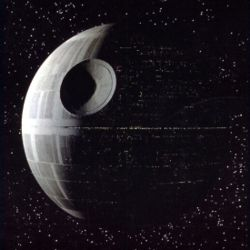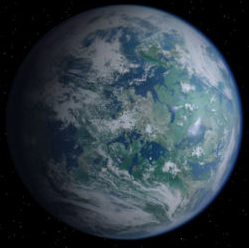
The Death Star is a space station and superweapon featured in the Star Wars space-opera franchise. Constructed by the autocratic Galactic Empire, the Death Star is capable of annihilating entire planets into rubble, and serves to enforce the Empire's reign of terror. Appearing in the original 1977 film Star Wars, the Death Star serves as a central plot point and setting for the movie, and is destroyed in an assault by the Rebel Alliance in the climax of the film. A larger Second Death Star is constructed in the events of the film Return of the Jedi featuring substantially improved capabilities compared to its predecessor. It is destroyed by the Rebel Alliance while under construction, however.

A doomsday device is a hypothetical construction — usually a weapon or weapons system — which could destroy all life on a planet, particularly Earth, or destroy the planet itself, bringing "doomsday", a term used for the end of planet Earth. Most hypothetical constructions rely on hydrogen bombs being made arbitrarily large, assuming there are no concerns about delivering them to a target or that they can be "salted" with materials designed to create long-lasting and hazardous fallout.
The interstellar space opera epic Star Wars uses science and technology in its settings and storylines. The series has showcased many technological concepts, both in the movies and in the expanded universe of novels, comics and other forms of media. The Star Wars movies' primary objective is to build upon drama, philosophy, political science and less on scientific knowledge. Many of the on-screen technologies created or borrowed for the Star Wars universe were used mainly as plot devices.
Halo, halos or haloes usually refer to:
Death is the irreversible cessation of all biological functions that sustain an organism.

Yavin is a fictional planet in the Star Wars galaxy. It first appeared in the 1977 film Star Wars and is depicted as a large red gas giant with an extensive satellite system of moons. The hidden military base of the Rebel Alliance is located on its fourth moon, Yavin 4.

Endor is a fictional moon in the Star Wars universe, known for its endless forests, savannahs, grasslands, mountain ranges, and a few oceans. The moon was the site of a pivotal battle depicted in Return of the Jedi. It is the homeworld of the sentient Dulok, Ewok, and Yuzzum species, as well as the semi-sentient Gorax and Wistie species. The Endor solar cycle was 402 GSC days orbital, with a breathable earth-like atmosphere conducive for humans and 8% surface water. It is where Darth Vader's funeral was held.

A megastructure is a very large artificial object, although the limits of precisely how large vary considerably. Some apply the term to any especially large or tall building. Some sources define a megastructure as an enormous self-supporting artificial construct. The products of megascale engineering or astroengineering are megastructures. The lower bound of megastructural engineering might be considered any structure that has any single dimension 1 megameter (1000 km) in length.

Alderaan is a fictional planet featured in the Star Wars franchise. It is blue-green in appearance, depicted as a terrestrial planet with humanoid inhabitants, and characterized by a peaceful culture. It is the home planet of Princess Leia Organa, one of the lead characters in the film series, as well as former Rebel shock trooper Cara Dune. In the original 1977 film, Alderaan is destroyed by the Death Star's superlaser.
Stellar engineering is a type of engineering concerned with creating or modifying stars through artificial means.
This is a list of occurrences of space elevators in fiction. Some depictions were made before the space elevator concept became fully established.

The Giants series is a group of five science fiction novels by James P. Hogan, beginning with his first novel, 1977's Inherit the Stars.
Star seed or starseed may refer to:
The fictional portrayal of the Solar System has often included planets, moons, and other celestial objects which do not actually exist in reality. Some of these objects were, at one time, seriously considered as hypothetical planets which were either thought to have been observed, or were hypothesized to be orbiting the Sun in order to explain certain celestial phenomena. Often such objects continued to be used in literature long after the hypotheses upon which they were based had been abandoned.
The planetary systems of stars other than the Sun and the Solar System are a staple element in many works of the science fiction genre.
Science fictional space warfare is main theme and central sub-genre of science fiction that can trace its roots back to classical times, and to the "future war" novels of the 19th century. With the Modern Age, directly with franchises as Star Wars and Star Trek, it's considered one of the most popular general sub-genres and themes of science fiction. An interplanetary, or more often an interstellar or intergalactic war, has become a staple plot device. Space warfare, represented in science fiction, has a predominant role, it's central theme and at the same time it's considered parent, overlapping genre of space opera, military science fiction and Space Western.

Jyn Erso is a fictional character in the Star Wars franchise, portrayed by English actress Felicity Jones in the 2016 film Rogue One. Jyn aids the Rebel Alliance in a desperate attempt to steal the plans to the Death Star, a weapon of the Galactic Empire with enough power to destroy an entire planet. The character was introduced as a child in the 2016 prequel novel Catalyst by James Luceno.
This page is based on this
Wikipedia article Text is available under the
CC BY-SA 4.0 license; additional terms may apply.
Images, videos and audio are available under their respective licenses.






